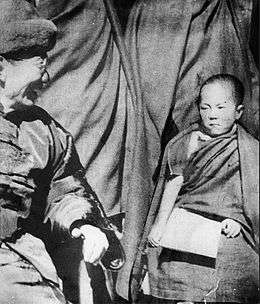Wu Zhongxin
Wu Zhongxin, or Wu Chung-hsin (traditional Chinese: 吳忠信; simplified Chinese: 吴忠信; pinyin: Wú Zhōngxìn; March 15, 1884 – December 16, 1959) was a General and government official of the Republic of China.[1] He was associated with the CC Clique. In his tenure as the Chairman of the Mongolian and Tibetan Affairs Commission of the Republic of China, Wu supervised the enthronement of the 14th Dalai Lama.[2][3] From late 1944 until early 1946 he was one of the few KMT governors of Xinjiang.
Wu Zhongxin | |
|---|---|
 Wu Zhongxin as pictured in The Most Recent Biographies of Important Chinese People | |
| Secretary-General to the President | |
| In office December 1948 – January 1949 | |
| Preceded by | Wu Dingchang |
| Succeeded by | Weng Wenhao |
| Civil and Military Governor of Xinjiang | |
| In office 29 August 1944 – 29 March 1946 | |
| Preceded by | Sheng Shicai |
| Succeeded by | Zhang Zhizhong |
| Chairman of the Mongolian and Tibetan Affairs Commission | |
| In office August 1936 – December 1944 | |
| Preceded by | Lin Yungai |
| Succeeded by | Luo Liangjian |
| Chairman of the Guizhou Provincial Government | |
| In office April 1935 – August 1936 | |
| Preceded by | Wang Jialie |
| Succeeded by | Gu Zhutong |
| Chairman of the Anhui Provincial Government | |
| In office April 1932 – May 1933 | |
| Preceded by | Chen Diaoyuan |
| Succeeded by | Liu Zhenhua |
| Personal details | |
| Born | March 15, 1884 Hefei, Anhui Province, China |
| Died | December 16, 1959 (aged 75) Taipei, Taiwan |
| Nationality | Republic of China |
| Political party | Kuomintang |
| Military service | |
| Allegiance | |
| Rank | |
Footnotes
- Biography of General Wu Zhongxin
- Andrew D. W. Forbes (1986). Warlords and Muslims in Chinese Central Asia: a political history of Republican Sinkiang 1911–1949. Cambridge, England: CUP Archive. p. 253. ISBN 0-521-25514-7. Retrieved 2010-06-28.
- Ondřej Klimeš (8 January 2015). Struggle by the Pen: The Uyghur Discourse of Nation and National Interest, c.1900–1949. BRILL. p. 197. ISBN 978-90-04-28809-6.

Wu Zhongxin, Republic of China's Chairman of the Mongolian and Tibetan Affairs Commission with Lhamo Dhondup, the future 14th Dalai Lama in Amdo about 1940. A ransom was paid to Ma Bufang to release the boy and his family to go to monastic education in Lhasa.
This article is issued from Wikipedia. The text is licensed under Creative Commons - Attribution - Sharealike. Additional terms may apply for the media files.